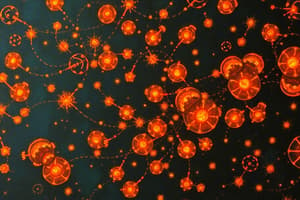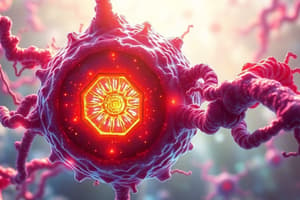Podcast
Questions and Answers
How does the electrochemical gradient influence ion transport across a cell membrane, and under what conditions does passive transport occur?
How does the electrochemical gradient influence ion transport across a cell membrane, and under what conditions does passive transport occur?
The electrochemical gradient, a combination of electrical and chemical forces, determines ion transport. Passive transport occurs when this gradient favors the movement of ions across the membrane without requiring energy input.
Describe the role of the Na+/Ca2+ exchanger (NCX) in regulating intracellular calcium levels, and explain the stoichiometry of ion exchange in this process.
Describe the role of the Na+/Ca2+ exchanger (NCX) in regulating intracellular calcium levels, and explain the stoichiometry of ion exchange in this process.
NCX is an antiporter that uses the sodium gradient to drive calcium efflux, removing calcium from the cell. For every calcium ion that is transported out, two sodium ions enter the cell.
Explain how the structure of voltage-gated potassium channels contributes to their function, focusing on the roles of the voltage-sensing domain and the pore domain.
Explain how the structure of voltage-gated potassium channels contributes to their function, focusing on the roles of the voltage-sensing domain and the pore domain.
The voltage-sensing domain responds to changes in membrane potential, initiating channel opening. The pore domain, formed by the last two building blocks, creates a selective pathway allowing only potassium ions to flow through the channel.
Explain how the polarity of a cell membrane (negative inside, positive outside) is established and maintained, and its significance for cellular function.
Explain how the polarity of a cell membrane (negative inside, positive outside) is established and maintained, and its significance for cellular function.
Discuss the role of calcium signaling in fertilization, including the mechanisms of calcium release and its downstream effects on egg activation.
Discuss the role of calcium signaling in fertilization, including the mechanisms of calcium release and its downstream effects on egg activation.
Describe how a P-type ATPase, such as the Na+/K+ pump or SERCA, utilizes phosphorylation to drive ion transport across cell membranes.
Describe how a P-type ATPase, such as the Na+/K+ pump or SERCA, utilizes phosphorylation to drive ion transport across cell membranes.
Compare and contrast the mechanisms of ion transport via simple diffusion, channel-mediated diffusion, and carrier-mediated transport.
Compare and contrast the mechanisms of ion transport via simple diffusion, channel-mediated diffusion, and carrier-mediated transport.
Elaborate on the role of active transport in generating and maintaining ion gradients across cellular membranes.
Elaborate on the role of active transport in generating and maintaining ion gradients across cellular membranes.
Explain the concept of 'signaling' in the context of cellular biology, and provide examples of how extracellular stimuli can induce changes in cell function.
Explain the concept of 'signaling' in the context of cellular biology, and provide examples of how extracellular stimuli can induce changes in cell function.
Describe the role of SERCA (Sarco/endoplasmic reticulum Ca2+-ATPase) in calcium signaling and explain how it contributes to the regulation of intracellular calcium concentrations.
Describe the role of SERCA (Sarco/endoplasmic reticulum Ca2+-ATPase) in calcium signaling and explain how it contributes to the regulation of intracellular calcium concentrations.
How do ion channels contribute to nerve-to-nerve transmission (neurotransmission)? Elaborate on the process and the specific ions involved.
How do ion channels contribute to nerve-to-nerve transmission (neurotransmission)? Elaborate on the process and the specific ions involved.
Discuss the role of ion channels in the 'flight or fight' response, particularly in relation to adrenaline signaling.
Discuss the role of ion channels in the 'flight or fight' response, particularly in relation to adrenaline signaling.
How do ion channels contribute to the precise timing and spatial localization of calcium signals within a cell, and why is this important for cellular function?
How do ion channels contribute to the precise timing and spatial localization of calcium signals within a cell, and why is this important for cellular function?
Explain the mechanism of secondary active transport, giving specific examples of how ion gradients are utilized to transport other molecules across the cell membrane.
Explain the mechanism of secondary active transport, giving specific examples of how ion gradients are utilized to transport other molecules across the cell membrane.
Discuss the various roles of calcium signaling in different cellular processes, providing specific examples of how calcium ions regulate exocytosis, gene transcription, and metabolism.
Discuss the various roles of calcium signaling in different cellular processes, providing specific examples of how calcium ions regulate exocytosis, gene transcription, and metabolism.
Explain the role and mechanism of PMCA (Plasma Membrane Calcium ATPase) in maintaining low intracellular calcium concentrations.
Explain the role and mechanism of PMCA (Plasma Membrane Calcium ATPase) in maintaining low intracellular calcium concentrations.
Describe the mechanism by which the Na+-K+ pump maintains ion gradients across the cell membrane, and discuss the consequences of its malfunction on cellular function.
Describe the mechanism by which the Na+-K+ pump maintains ion gradients across the cell membrane, and discuss the consequences of its malfunction on cellular function.
Explain how differences in ion concentrations between the inside and outside of a cell influence the resting membrane potential, and how this potential is crucial for cell excitability and function.
Explain how differences in ion concentrations between the inside and outside of a cell influence the resting membrane potential, and how this potential is crucial for cell excitability and function.
Describe how changes in membrane potential affect the opening and closing of voltage-gated ion channels, and discuss the significance of this process in the generation of action potentials.
Describe how changes in membrane potential affect the opening and closing of voltage-gated ion channels, and discuss the significance of this process in the generation of action potentials.
Describe how alterations in the expression or function of ion channels can lead to various diseases (channelopathies), providing specific examples of diseases linked to mutations in sodium, potassium, or calcium channels.
Describe how alterations in the expression or function of ion channels can lead to various diseases (channelopathies), providing specific examples of diseases linked to mutations in sodium, potassium, or calcium channels.
Discuss the differences in ion concentrations inside and outside a typical mammalian cell, and explain how these differences are maintained.
Discuss the differences in ion concentrations inside and outside a typical mammalian cell, and explain how these differences are maintained.
Describe the role of ion channels in processes such as exocytosis, muscle contraction, and proliferation. Be sure to include specific ions and channels involved.
Describe the role of ion channels in processes such as exocytosis, muscle contraction, and proliferation. Be sure to include specific ions and channels involved.
Describe ion transport mechanisms that are active versus passive. What are the energy requirements, and what direction do the ions travel?
Describe ion transport mechanisms that are active versus passive. What are the energy requirements, and what direction do the ions travel?
Discuss the specific structural domain requirements for the Voltage gated K+ channel and briefly explain how each domain contributes to the channels function.
Discuss the specific structural domain requirements for the Voltage gated K+ channel and briefly explain how each domain contributes to the channels function.
Describe the role of a stimulus on reactions such as exocytosis, contraction, and metabolism. How does the stimulus change the normal rate of these processes?
Describe the role of a stimulus on reactions such as exocytosis, contraction, and metabolism. How does the stimulus change the normal rate of these processes?
How are ion gradients generated, and what role does ATP hydrolysis play in this process?
How are ion gradients generated, and what role does ATP hydrolysis play in this process?
How does calcium signaling interact with gene transcription to change the expression profile of a cell?
How does calcium signaling interact with gene transcription to change the expression profile of a cell?
Describe how the distribution of ions can be used to determine the positivity or negativity of a cell.
Describe how the distribution of ions can be used to determine the positivity or negativity of a cell.
Explain the molecular mechanism by which an extracellular ligand binding the receptor and initiating a cellular response. What types of receptors are used?
Explain the molecular mechanism by which an extracellular ligand binding the receptor and initiating a cellular response. What types of receptors are used?
What would occur to the body during the flight or fight response if one were to block the action of adrenaline? What are the specific targets that would be affected?
What would occur to the body during the flight or fight response if one were to block the action of adrenaline? What are the specific targets that would be affected?
Flashcards
Signaling
Signaling
The cascade of processes by which an extracellular stimulus affects a change in cell function.
Signaling through ion channels
Signaling through ion channels
Proteins embedded in the membrane that open to allow ions to flow across.
Signaling through receptors
Signaling through receptors
When a signal binds to a receptor protein, initiating a series of events that change cell function.
Selective ion channels
Selective ion channels
Signup and view all the flashcards
Calcium (Ca2+) in signaling
Calcium (Ca2+) in signaling
Signup and view all the flashcards
Exocytosis
Exocytosis
Signup and view all the flashcards
Contraction
Contraction
Signup and view all the flashcards
Metabolism
Metabolism
Signup and view all the flashcards
Gene Transcription
Gene Transcription
Signup and view all the flashcards
Fertilization
Fertilization
Signup and view all the flashcards
Proliferation
Proliferation
Signup and view all the flashcards
Hypertrophy
Hypertrophy
Signup and view all the flashcards
Membrane potential
Membrane potential
Signup and view all the flashcards
Electrochemical gradient
Electrochemical gradient
Signup and view all the flashcards
Passive ion transport
Passive ion transport
Signup and view all the flashcards
Active ion transport
Active ion transport
Signup and view all the flashcards
Ion gradients
Ion gradients
Signup and view all the flashcards
Na+/K+ pump
Na+/K+ pump
Signup and view all the flashcards
Calcium pump
Calcium pump
Signup and view all the flashcards
Uniport
Uniport
Signup and view all the flashcards
Symport
Symport
Signup and view all the flashcards
Antiport
Antiport
Signup and view all the flashcards
Sodium-calcium exchanger (NCX)
Sodium-calcium exchanger (NCX)
Signup and view all the flashcards
Study Notes
- Signalling involves a cascade of processes initiated by an extracellular stimulus, like a neurotransmitter or hormone, to change cell function.
Examples of Signalling
- Glutamate acts as a neurotransmitter for nerve-to-nerve transmission (neurotransmission).
- Adrenaline triggers a flight or fight response.
Types of Signalling
- Signalling through ion channels occurs when proteins embedded in the membrane open, allowing ions to flow through.
- Signalling through receptors involves a signal binding to a receptor protein, initiating a cascade of events that changes cell function.
Signalling Through Ion Channels
- Ion channels are often selective for particular ions, allowing movement of different ions.
- For example, Potassium channels only allow Potassium to enter the cell, and Calcium and Sodium channels work similarly.
- Calcium is a ubiquitous signalling ion that is used throughout signalling in many ways
- For example, calcium levels spike during egg fertilization with sperm
Calcium Signalling
- Involved in exocytosis, contraction, metabolism, gene transcription, fertilization, proliferation, and hypertrophy.
- Cell membranes are normally impermeable to ions.
- Gases freely travel across membranes.
- Ions like sodium, potassium, calcium, and chloride, being charged, are usually prevented from crossing the membrane.
- Channel proteins transport ions across membranes.
- Differences in ion concentrations across membranes are significant
Ion Transport
- Can be either passive or active.
- Passive transport includes simple diffusion, channel-mediated, and carrier-mediated mechanisms.
- Active transport requires energy.
- Passive transport is determined by the electrochemical gradient.
- Cells have a membrane potential, resulting in a slight electrical imbalance.
- The inside of the cell is negative relative to the outside, which has a lot of positive charge resulting in flow from outside to inside.
- Both electrical and chemical gradients affect ion transport such that positive goes to negative.
Ion Concentrations (mM)
- Intracellular: Na+ (5-15), K+ (140), Mg2+ (0.5), Ca2+ (10^-4), H+ (7 x 10^-5 or pH 7.2)
- Extracellular: Na+ (145), K+ (5), Mg2+ (1-2), Ca2+ (1-2), H+ (4 x 10^-5 or pH 7.4), Cl- (110)
How Ion Gradients Are Generated
- Generated by active transport
- Energy is required to move ions against their concentration gradient.
- This process requires ATP to drive uphill movement of ions.
Sodium - Potassium Pump
- Generates sodium and potassium gradients across the plasma membrane.
- For every molecule of ATP hydrolysed, 3 sodium ions are moved out and 2 potassium ions are moved in.
- This is an active transport process where ATP is hydrolysed to ADP + Pi.
- Sodium is ejected out of the cell, and potassium is transported into the cell.
- This pump is a P-type ATPase
- "P" stands for phosphorylation as sodium can bind easily to the protein causing its phosphorylation by ATP, driving a conformational change that releases sodium.
Calcium Pump
- Generates calcium gradients across the plasma membrane.
- PMCA (Plasma Membrane Calcium ATPase) keeps calcium concentration low inside the cell by ejecting calcium outside using a P-type ATPase.
- SERCA (Sarco/endoplasmic reticulum Ca2+-ATPase) also uses a P-type ATPase to generate calcium gradients across intracellular stores.
- It takes calcium from the cytoplasm to the lumen of the ER or SR.
Ion Gradients Used For Secondary Transport
- Involve uniport, symport (coupled in the same direction), or antiport (coupled, opposite directions).
- Sodium gradient is used to drive Calcium efflux via the Sodium/Calcium exchanger (antiporter).
- NCX exchanges 2 Sodium in for Calcium out.
Ion Channels
- Voltage-gated and have 6 transmembrane regions (S1-S6).
- They have 2 domains
- The first 4 building blocks form a voltage-sensing domain that responds to voltage to open the channel.
- The last 2 building blocks (S5, S6) form the pore domain, which has a hole through which ions flow.
- Voltage-gated K+ channels have 4 subunits.
- Sodium/Calcium channels have 4 linked subunits.
Gated Channels
- Can be ligand-gated (extracellular or intracellular) or mechanically gated.
Studying That Suits You
Use AI to generate personalized quizzes and flashcards to suit your learning preferences.




